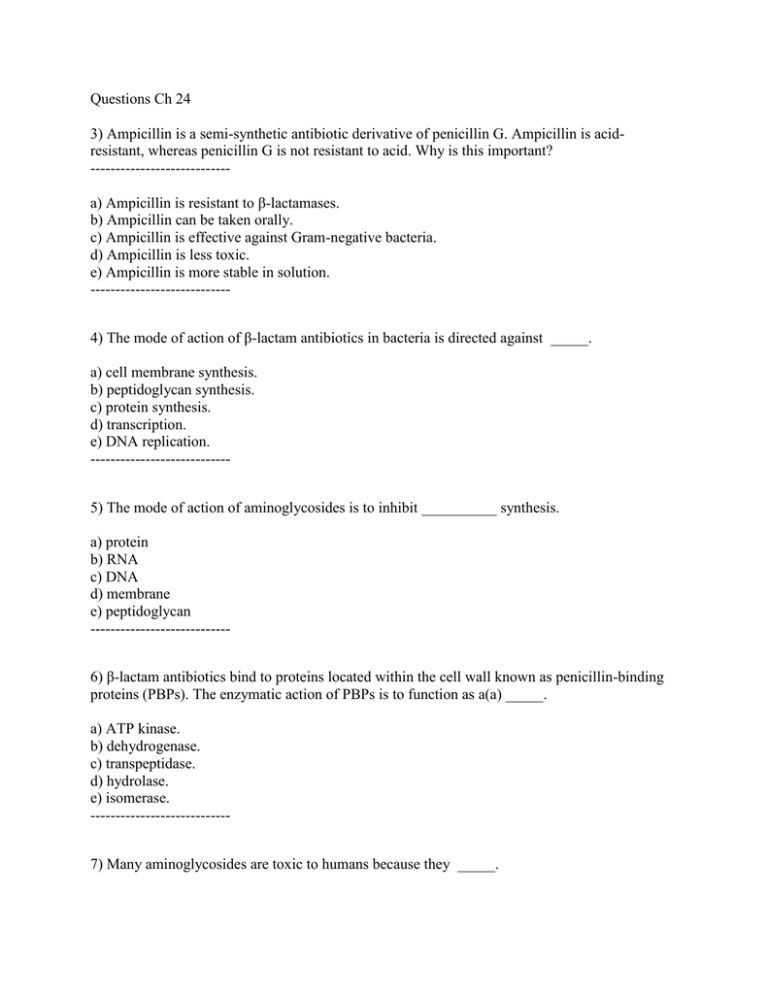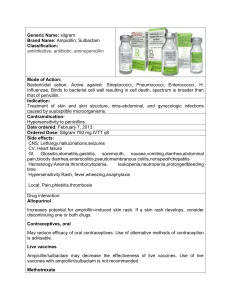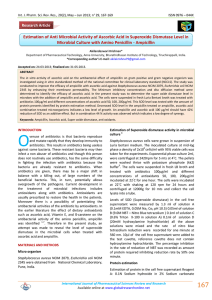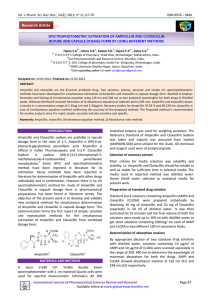Questions Ch 24
advertisement

Questions Ch 24 3) Ampicillin is a semi-synthetic antibiotic derivative of penicillin G. Ampicillin is acidresistant, whereas penicillin G is not resistant to acid. Why is this important? ---------------------------a) Ampicillin is resistant to β-lactamases. b) Ampicillin can be taken orally. c) Ampicillin is effective against Gram-negative bacteria. d) Ampicillin is less toxic. e) Ampicillin is more stable in solution. ---------------------------4) The mode of action of β-lactam antibiotics in bacteria is directed against _____. a) cell membrane synthesis. b) peptidoglycan synthesis. c) protein synthesis. d) transcription. e) DNA replication. ---------------------------5) The mode of action of aminoglycosides is to inhibit __________ synthesis. a) protein b) RNA c) DNA d) membrane e) peptidoglycan ---------------------------6) β-lactam antibiotics bind to proteins located within the cell wall known as penicillin-binding proteins (PBPs). The enzymatic action of PBPs is to function as a(a) _____. a) ATP kinase. b) dehydrogenase. c) transpeptidase. d) hydrolase. e) isomerase. ---------------------------7) Many aminoglycosides are toxic to humans because they _____. a) interfere with lipid synthesis in human cells. b) disrupt kidney function. c) interfere with protein synthesis in human cells. d) cause the heart to beat abnormally. e) block DNA replication in human cells. ---------------------------10) The mode of action of sulfa drugs is to inhibit _____. a) peptidoglycan synthesis. b) folic acid biosynthesis. c) transcription. d) tryptophan biosynthesis. e) protein synthesis. ---------------------------- 15) Which one of the following is not a mechanism of antimicrobial drug resistance? a) enzymatic inactivation of the drug b) removal of the drug from inside the cell c) blocking the uptake of the drug into the cell d) incorporation of the drug into cell material e) alteration of the drug’s target site ---------------------------17) Methicillin resistant Staphylococcus aureus (MRSA) has acquired the mecA gene from an unknown source. This gene encodes for a methicillin resistant _____. a) efflux protein. b) penicillin-binding protein. c) β-lactamase. d) acetyltransferase. e) porin. ---------------------------22) All of the following are approaches used to help reduce the incidence of antimicrobial drug resistance except _____. a) the use of very high concentrations of the drug. b) use of a narrow spectrum antibiotic to treat a specific infection. c) use of a combination of antibiotics. d) good hygiene, such as frequent hand washing to prevent the spread of drug resistant microbes. e) the use of antibiotics only when absolutely necessary. ---------------------------- 1. What is meant by the term “selective toxicity”? ---------------------------2. Why is selective toxicity a particular challenge in finding drugs for viruses and eukaryal pathogens? ---------------------------- 3. What is the mode of action of β-lactam antibiotics? ---------------------------4. Why are antimicrobial drugs often used in farmed animals, and how is this thought to contribute to the rise of drug-resistant microbes?











